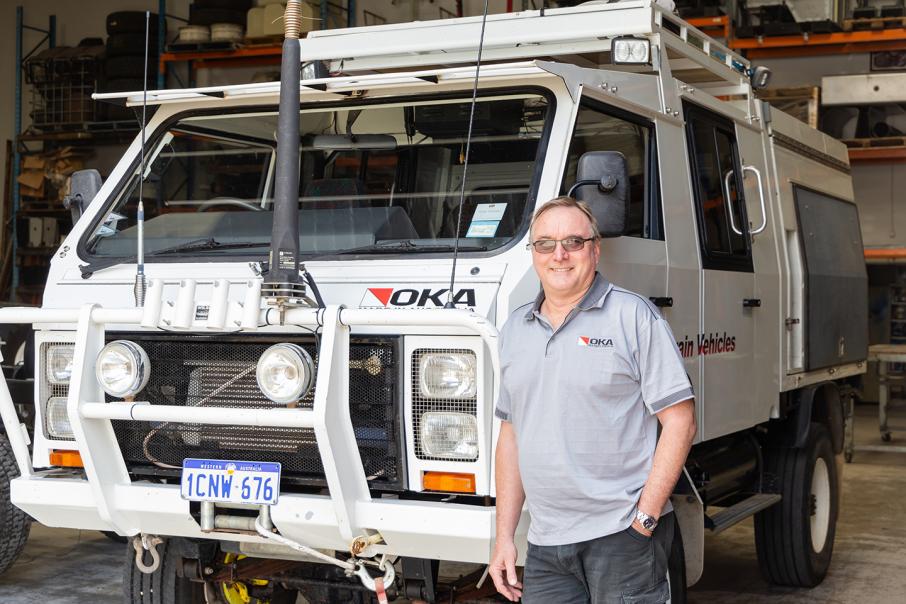Built for the state’s remote interior, OKA vehicles could be making a comeback.


Built for the state’s remote interior, OKA vehicles could be making a comeback.
In a warehouse in the O’Connor industrial area of Perth’s southern suburbs, Dean Robinson is quietly tinkering away at an attempt to revive the state’s most notable homegrown vehicle manufacturer.
Mr Robinson last year brought the OKA vehicle brand and all the assets linked to the four-wheel drive vehicle, which was developed and manufactured in Western Australia from the mid-1980s until the late 2000s, back into local hands.
His full-time focus on OKA follows more than six years as a supplier of parts for the hundreds of rugged off-road vehicles that still operate, mainly across Australia. The parts business, which he owned with his brother Lloyd, operated very much in the background of construction firm Robinson Build-Tech, which succumbed to the state’s downturn when it went under in 2015.
Mr Robinson makes it clear that the new business, OKA All Terrain Vehicles, is not in production but is focused on developing a new model – although the business does build what he calls an R Series of exploration vehicles remanufactured to customer specifications.
“Our commitment is to continue and enhance the substantial legacy that OKA has forged since 1986 as an unrivalled all-terrain, two-tonne capable vehicle that is adaptable for many applications, not readily exploited by other vehicle manufacturers,” Mr Robinson told Business News.
“Our challenge is to build on the brand and to enhance the considerable strengths in the existing design.”
Started in the mid-1980s by property entrepreneur Michael Walker, the former listed group OKA Motor Company had a chequered history throughout the 1990s, as investors and the many local enthusiasts for the vehicle’s abilities and potential found their hopes dashed by quality and volume issues, which reflected a cottage manufacturer rather than a modern vehicle maker.
Nevertheless, its unique suspension system meant users – including tour companies and mining explorers – could reach remote locations inaccessible to most vehicles, a typical scenario in outback Western Australia.
Hundreds of vehicles, with loyal owners, still survive and can occasionally be seen on the streets of Perth as they return to the urban centre for refits and new parts.
In 1995, foreign interests came on the register as a result of a convoluted transaction whereby Malaysian company Hicom took a 10 per cent stake for $2.1 million so French motor company Renault could discharge a local investment obligation that had arisen from a contract it had won to supply buses to Transperth.
The WA company, however, continued to overpromise and underdeliver to shareholders, struggling to overcome issues with its new LT model.
In 1999, OKA’s major shareholder, Malaysian entrepreneur Paari Vell, took control of the assets and renewed hope for the WA manufacturing sector.
It was not to be. The business languished behind the private veil, seemingly focused on research and development.
A new NT series was launched in 2000, but only 16 were ever produced, according to Mr Robinson. The first vehicle, still owned by the original purchasers Ruedi Schoensleben and Susi Schoensleben-Vogt, happens to be back in WA after touring the world and clocking up more 200,000 kilometres (see page 49).
By 2011, Mr Vell had plans to pack up shop and start afresh in Malaysia.
When that did not happen, Mr Robinson bought the parts in order to supply the needs of users, and then negotiated to acquire all the OKA assets.
“(My focus) is building that prototype and then proving it,” he said.
“It needs to be severely tested.
“There is a lot (of intellectual property) that exists.
“The design works, we just have to make it more robust and capable.”
Mr Robinson said his biggest challenge was finding the time and funds to develop a new model and meet the standards of modern vehicle design, let alone users who demand reliability for good reason.
“If I had a $1 million I would be happy,” Mr Robinson said, adding that he would be open to investors or some other form of R&D funding to get him past this phase.
“Having R&D funding would be good.
“I have spoken to a couple of the bigger companies in town.
“My biggest problem is time.”






